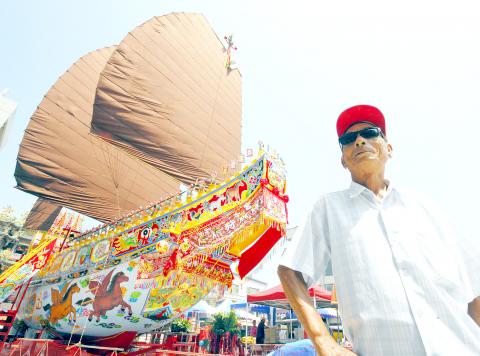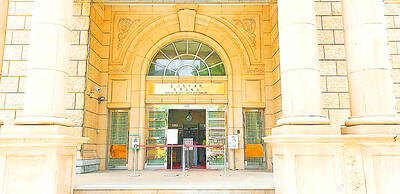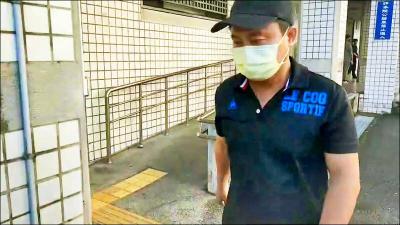For the past 46 years, craftsman Su Chun-fa (蘇春發) in Kaohsiung has built wooden ships used in plague offering ceremonies — known as Wang Yeh boats — for temples nationwide.
In each ceremony, the massive boats Su and his workmen painstakingly assemble and decorate are burned as part of plague offerings to the Wang Yeh plague gods.
The 73-year-old Su has made over 80 Wang Yeh ships in his career.

Photo courtesy of Lin Tai-long
He received official recognition from the Ministry of Cultural Affairs as a key figure in the preservation of the traditional art of Wang Yeh shipbuilding and the Kaohsiung History Museum is anticipating the publication of a book titled The Man Who Builds Wang Yeh Ships: The Craft of Su Chun-fa.
Chen Min-hsiung (陳敏雄), an adviser to Jin Luang Gong (金鑾宮), a temple in Kaohsiung’s Cieding District (茄萣), described Su as “a genius” shipwright.
Su’s boats were “beloved by the Cieding community” because they look “sleek, classy and agile,” and other Wang Yeh ships are “clumsy and boring” when compared with his creations, Chen said, adding: “Su does not use blueprints; he sees the plans in his head.”
Su was born to a fisherman’s family of eight children in Baishalun (白沙崙), a then-fishing town in Kaohsiung’s Cieding.
Su’s mother was injured during an airstrike in the Second World War, leaving her blind. His father worked hard to feed the family and sent Su away while he was still an infant, Su said.
Su said he did not know his birth family until he was 15 years old, when he was reunited with his biological parents.
Before building ships for the plague gods, Su was a shipwright for Baishalun’s fishermen, which at its peak was the largest fishing harbor in Cieding and had between five and six workshops.
Following his fourth eldest brother, Su Chun-man (蘇春滿), Su Chun-fa entered the shipwright trade without finishing elementary school, and worked until he was 28 years old, at which time the factory switched to fiberglass production, a material he is allergic to.
That year, Su Chun-fa became a Wang Yeh shipwright.
Wang Yeh ships were almost always made with papier-mache at that time, and Wang apprenticed under the only maker of wooden Wang Yeh ships in Cieding, a master from Penghu.
He worked on his first Wang Yeh ship in 1970 for Wanfugong (萬福宮), a temple in Baishalun.
Though Su Chun-fa had a mentor, he said he learned only the basics under his master and was largely self-taught.
Su Chun-fa liked to tinker with the Wang Yeh ships, making them not only more aesthetically pleasing, but also more functional and better equipped by researching sailing ships.
Su Chun-fa said he was the first to put working blackpowder cannons on Wang Yeh ships, a trend that had caught on with other makers.
He said he created his ships with the mindset that he was making them “for every person in Taiwan to see,” and he is always thinking of ways to create “a real stir” with his designs.
“A Wang Yeh ship that rolls out of the shop is going to burn pretty soon to be given to the gods, but the Wang Yeh ship is also Wang Yeh’s vehicle. I do not cut corners on that. Every ship I built is made to specifications with real timber, and they are a lot more expensive than what my colleagues make elsewhere,” he said, adding that as a result, he is often less competitive with temples that commission Wang Yeh boats when it comes to price.
Making the ships is a trade that requires hard work and real sacrifices, he said.
Su has lost two fingers on his left hand to a machine in a workplace mishap, which he attributed to not following the temple divinations that dictated the size and dimension of the ships, but also the time that work could be done on them.
For those reasons, he said he worries about the future of the Wang Yeh shipwrights’ craft.
“Wang Yeh shipbuilders do not have regular work crews. When temples need the ships, they give the commission to the few Cieding-based masters. The hours are unstable and you have to work away from home. The pay is less than the salary of interior decoration carpentry, and mostly only old masters are working out of a sense of obligation. I worry about passing on the torch,” he said.

South Korean K-pop girl group Blackpink are to make Kaohsiung the first stop on their Asia tour when they perform at Kaohsiung National Stadium on Oct. 18 and 19, the event organizer said yesterday. The upcoming performances will also make Blackpink the first girl group ever to perform twice at the stadium. It will be the group’s third visit to Taiwan to stage a concert. The last time Blackpink held a concert in the city was in March 2023. Their first concert in Taiwan was on March 3, 2019, at NTSU Arena (Linkou Arena). The group’s 2022-2023 “Born Pink” tour set a

CPBL players, cheerleaders and officials pose at a news conference in Taipei yesterday announcing the upcoming All-Star Game. This year’s CPBL All-Star Weekend is to be held at the Taipei Dome on July 19 and 20.

The Taiwan High Court yesterday upheld a lower court’s decision that ruled in favor of former president Tsai Ing-wen (蔡英文) regarding the legitimacy of her doctoral degree. The issue surrounding Tsai’s academic credentials was raised by former political talk show host Dennis Peng (彭文正) in a Facebook post in June 2019, when Tsai was seeking re-election. Peng has repeatedly accused Tsai of never completing her doctoral dissertation to get a doctoral degree in law from the London School of Economics and Political Science (LSE) in 1984. He subsequently filed a declaratory action charging that

The Hualien Branch of the High Court today sentenced the main suspect in the 2021 fatal derailment of the Taroko Express to 12 years and six months in jail in the second trial of the suspect for his role in Taiwan’s deadliest train crash. Lee Yi-hsiang (李義祥), the driver of a crane truck that fell onto the tracks and which the the Taiwan Railways Administration's (TRA) train crashed into in an accident that killed 49 people and injured 200, was sentenced to seven years and 10 months in the first trial by the Hualien District Court in 2022. Hoa Van Hao, a